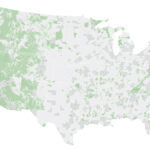
Will COVID Forever Change Where Americans Work?
The COVID-19 pandemic has forced a massive shift in the American workforce from office to home that is reminiscent of the move from farm to factory during the Industrial Revolution.
According to Gallup, as many as 70% of Americans said they worked from home at least part of the time in May (up from 43% last year). More than 82% of corporations say they will allow employees to work remotely part-time after the pandemic and 47% will allow full-time.
When I asked my father how he handled the transition, he told me that the “older folks” in his office have really embraced the “Zoom environment.” My father worked in an office for nearly 30 years before COVID forced him to work from home.
In some ways, the shift was harder for companies than for individuals, he said. “Companies that didn’t have a good technological infrastructure in place struggled in the beginning, but I think they caught up quickly. The pandemic pushed a lot of companies into the digital world that may not have been there yet.”
Companies like Zoom and Microsoft have flourished amid the pandemic as demand for new communication tools increases. Zoom reported 300 million daily meeting participants in April, up from 10 million in December, and recently unveiled its first dedicated at-home videoconferencing tech.
People are also communicating at different times now that they aren’t driving to and from work.
Use of the Microsoft Teams app is up 20% between the hours of 8:00 am and 9:00 am and 6:00 pm and 8:00 pm and has jumped by more than 200% on weekends.
“We’ve always been connected, but now it’s the only way we communicate,” my father said. “The lines between work and non-work have blurred…And people need to, you know, set boundaries when their day ends or they find out they are just working all the time.”
Working remotely isn’t the same for everyone, he added.
“I think the majority of people have the discipline to work from home, but there is absolutely a percentage of people that struggle with it; they get distracted with day-to-day things,” he said. “You must have patience. This is difficult for people with kids and grandparents at home; that’s real life and your family comes first…I also remind myself that these Zoom calls – people have pets and kids. If they interfere that’s fine, it’s life.”
Working remotely has actually made my dad feel more connected to his colleagues, he explained. “In some ways, we have become more engaged with our teams just to make sure people are working okay in this ‘new normal,’” he said, adding that it’s important to keep your camera on as much as possible.
In response to the evolving needs of the American workforce, a new company called Sidekick has introduced a tablet that stays on all the time, giving colleagues the ability to speak with one another as if they were sitting in the same room. Another startup, called Firstbase, works with companies to furnish home offices.
My dad’s home office consists of a desk and a laptop and not much else. He still wears a dress shirt every day, but says he doesn’t mind if his coworkers are in sweats. “When people see me on Zoom, I want to look exactly like I did in the office,” he told me.
My father added that he looks forward to working full-time in the office after COVID and even misses driving to work. “Even though the commute was short, the ability to disconnect for five minutes in the morning, that’s something I miss.”

























IRS needs to reinstate home office deductions which they stopped in 2018. While there were abuses, perhaps a form, that the employer would complete, listing work responsibilities of the employee that would be required for the employee to claim home office expenses, would solve most of this problem.